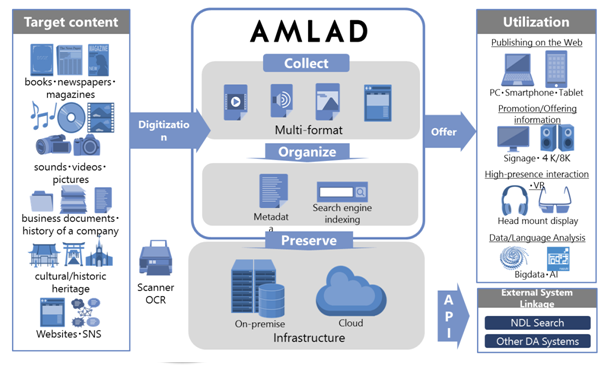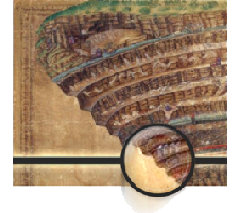Digital archive service AMLAD
Preserve and disseminate valuable ancient books, manuscripts, prints, visual and audio data, business documents,… of Galleries, Libraries, Archives, Museums, Enterprises, etc. into digital data.
Overview
NTT DATA's digital archive service AMLAD™*1 (Advanced Museum Library Archives Deposit) is a service that enable to preserve and disseminate valuable ancient books, manuscripts, prints, visual and audio data, business documents,… of Galleries, Libraries, Archives, Museums, Enterprises, etc. into digital data, not only for storage, but also for presentation to the public as indexed data searchable from computers, smartphones, and tablets.
- *1 "AMLAD" is a trademark or registered trademark of NTT DATA Corporation in Japan, Europe (CTM) and United States.

AMLAD, NTT Data’s digital archive service (begun in 2012), is the result of consolidating many years of NTT Data’s technology expertise and know-how
In combination with our BPO for digitization, we can provide comprehensive service for digital archives: from digitization to publication. Since then, it can support the administrative reform (paperless solution).

We provide comprehensive service from digitization, system implementation to support
Targets
Targets do not necessarily be Libraries, Museums and Archives. All the entities who own big amount of contents to be digitally archived can be targeted.

Customers
- Central government, local government organizations
- Libraries, Educational institutions, Medical institutions
- Television, Broadcaster, Radio stations
- Smart City
- Enterprises, Banks
Provide comprehensive service for digital archives
With AMLAD
01
Digitization
Eternal preservation through digitization

MLA collections include ancient books, manuscripts, artwork, photographs, and film that are precious cultural heritages that must be preserved for future generations. However, the utmost care and attention taken in the preservation of collections cannot always eliminate the effects of aging brought on by the advancement of time which could make some collections inaccessible in the future. Pre-emptively digitizing collections ensures long term preservation and backup of the contents in the event that originals become inaccessible for any reason, and provides various opportunities for using digitized data.
02
Discovery
Searching the collection in various ways

The digitized collections can be searched online by end users, with advanced search options based on keywords and categories associated with each item. “Discovery Search” enables to search over several GLAMs includes your organization in one query, which brings new discovery to the end users.
03
Dissemination
Digitized data can be open to the public through multi device

Archived collections made widely available to the public including researchers and GLAM users on various devices from computers to smartphones, tablets, and other online devices helps contents to be distributed extensively and the valuable information to be inherited by future generations.
Cross search

Cross search functions for discovering documents across various GLAM collections: AMLAD stores metadata with its "Mapping" method, linking different metadata to each other. For example, by linking "Book title" from Library books and "Subject" from Archive documents, AMLAD enables end-users to run a single query to find appropriate information stored in multiple GLAM collections.
Various searches

Variety of search methods including Keyword Search, Category Search. and AutoSuggest: AMLAD provides various search methods including Keyword Search, Category Search, AutoSuggest, Refined Search, Associative Search, and "Did you mean" Search. Users can easily search and find documents across various institutions and their data. AMLAD simplifies the content search process for users to find desired documents, while simultaneously offering related content suggestions thus providing added value and context with ease.
High definition images

AMLAD handles documents in various formats such as Images, Videos, Audio, and Text: AMLAD stores high definition images and displays crisp images on browsers. Smoothly zoom in and out of high definition images with intuitive and user-friendly interface of the browser. Watermark technology to prevent inappropriate uses such as copying of protected images can easily be implemented.
Multiple device support

Supports various devices including PCs, Tablets, and Smartphones: AMLAD supports the latest OS and browsers where special plug-ins are not required even for viewing movie and image files in JPEG 2000. Users can view images on their device browsers or by using specialized Apps on their tablets and smartphones. By using the digital book reader application, users can browse documents by turning pages, just like a physical book.
Multiple formats

Display high definition images with user friendly interface: AMLAD "Mapping" function allows documents of various formats to be processed regardless of their file type. Even for a mixed media digital library, existing metadata are recorded across formats, eliminating the hassle of manually converting data.
Compliance with international standards

Flexible implementation to adhere to various international standards: AMLAD complies with several international standards in the digital archiving field including OAIS (Reference Model for an Open Archival Information System, which is a framework for archiving systems for long term preservation of digital information), Dublin-core, METS, MODS, and EAD. Therefore, in addition to Libraries, Museums, Archives, and other institutions can easily install and use AMLAD. Additionally, standardized linkage protocols such as OAI-PMH and SRU/SRW are available on AMLAD, thus allowing easy linking to external institutions that manage their content using different metadata formats.
The Vatican Apostolic Library is conducting a digitization project in order to create a digital archive with a view to handing on these precious handwritten materials to future generations as an eternal cultural legacy. NTT DATA Corporation has agreed to participate in this Vatican Apostolic Library digitization project, an endeavor that can be considered a major contribution to humanity. In April 2014, NTT DATA began working on the project, with plans to digitize approximately 3,000 handwritten manuscripts over the course of the next four years. Since most of the manuscripts are written on fragile material such as papyrus, they are carefully scanned using specialized equipment followed by adding metadata such as author and keywords, and finally the data is stored in a data center located in Vatican City State. Currently, these digitized collections are partially open to the public online in order to enable visitors search and view them.
http://digital.vatlib.it/en/collection
Tens of thousands of images and half a million indexed data of the Akita Prefectural Library as well as documents owned by six external institutions including museums, public record offices, and art galleries have been digitized, cross indexed, and made searchable. Each institution originally had used different cataloguing formats, however this complication has been resolved by unifying them using the AMLAD mapping feature, thus powering Discovery Service. The digitized data has been linked to the National Diet Library, to effectively share electronic information and to function as a community hub especially for elderly and young families.



